Chinese Iron and Steel Industry: Large-Scale Mergers to Ease Overcapacity
|
Industry Highlights Industry Suffering from Overcapacity, Push to Strengthen Exports China’s iron and steel industry is facing a harsh winter due to overcapacity and falling product prices, with experts calling for a boost in mergers and export activity in order to resolve these issues. However, the progress of mergers and reorganisation has essentially been precluded by local governments that are burdened with massive debts, and the export trade— although well-supported by government policy— has encountered backlashes against anti-dumping from overseas markets. Companies Move toward Consolidation and Mergers Despite the corruption in local government, it is anticipated that, in tandem with global trends, a number of large-scale mergers and acquisitions among Chinese iron and steel manufacturers will take place over the period of 2015–2020. As the market becomes consolidated, it is likely that production will be concentrated towards the coastal region, with the emergence of two to three conglomerates in Northern and Eastern China. Aiming for Domestic Supply of High-End Products The automobile and energy resource industries will gradually replace the construction industry— which currently holds a roughly 60% market share— to become the largest sources of demand for steel materials. At present, high-end industries are dependent upon imports of special alloys of the kind that are often used in facilities such as nuclear power generators. The establishment of a stronger system for technological research, development, and management should enable the supply of such materials in future. |
|
Macroeconomics of China In 2010, China was ranked second in the world in terms of GDP. However, its GDP per capita remained low at USD 7,750 (as of 2014) and is equivalent to that of mid- to low-income countries, exhibiting the gap with OECD countries. There is a significant gap in economic development between coastal regions (including special economic zones) and inland regions, with China’s top 30 cities by GDP accounting for almost 50% of the country’s total GDP. Evening out these regional differences is one of the major tasks for the Chinese government. The figures of each key index disclosed by the Chinese Academy of Social Science are either falling year-on-year or growing by a very small amount. Although these figures are said to be “adjusted” to fit government targets, they nonetheless demonstrate an economic slowdown in the market. The reorganisation of China’s iron and steel industry has been drawing worldwide attention because it is related to a multitude of industries including infrastructure construction, machinery and equipment, shipbuilding, automobiles, and household appliances. Finally, it is important for industry observers to pay close attention to the Xi government’s upcoming 13th Five-Year Plan (2016–2020). Such policies have a substantial influence on industry development in China. |
|
Basic Policies and Principles of the Xi Government Doubling Both GDP and Income per Capita in Rural and Urban Regions by 2020 from 2010 The Chinese government under the previous Hu-Wen Administration (2003–2012) revised its economic development framework from “a stabilised and relatively rapid growth” to “a sustainable steady growth”, and reduced its target average annual GDP growth rate from 10% to 7%, pulling itself out of its number-obsessive focus on double-digit growth.*The Chinese government has been extraordinarily resolute in its commitment to show 7% GDP growth, using obscure calculation methods to do so. Therefore, there are some economists who claim that China’s 7% GDP growth is essentially 0% in OECD countries, and anything below 7% indicates a negative growth. The Chinese government has also attempted to shift its economic development focus from export and investment to domestic demand, under which investment, consumption, and exports play equal roles. Improving Livelihood Stability and Promoting Urbanisation in the Mid- to Long-Term (By 2020) The Chinese government aims to improve livelihood stability and achieve economic recovery through boosting construction of indemnificatory housing for low- to mid-income households and exploring further development of its urbanisation projects, under which six new districts (to be directly administered by the central government) will be established. China’s market mechanisms will undergo structural reform, wherein large-scale government expenditure will be curbed to restrain the country’s swelling debts and industrial sectors such as railway investment will make efforts to lure more private capital.The Belt and Road Strategy, together with the establishment of the Asian Infrastructure Investment Bank (AIIB), will be conducive to enhancing China’s influence within Asia and prevent the country from becoming isolated. It will also help to export China’s excess production capacity. |
|
Beijing’s Two Biggest Concerns Overcapacity in Major Industries It is believed that China’s current overcapacity crisis can be attributed to the CNY 4 trillion economic stimulation package that was launched in 2009. In addition to the iron and steel industry, other industries such as cement, shipbuilding, and solar power panel manufacturing are also facing similar overcapacity issues. The government has taken initiatives to combat this by discarding ageing and outdated facilities, prohibiting manufacturers from blind expansion of their production scales, and attempting to streamline the industry through consolidation. However, the issue of overcapacity remains unresolved, with a large number of companies in the iron and steel industry showing blatant disregard for the central government’s orders and continuing to increase their output capacity. Regional Issues On a regional level, there are issues such as the accumulation of debt by local governments, environmental pollution (air, soil, and water) due to the abovementioned blind expansion in the industry, and regional unbalances in economic development. In addition, trends such as a decreasing population and unfavourable sales of real estate have become increasingly significant in Tier 2 and 3 cities as youths are leaving their hometowns. |
|
Analysis – On China’s Iron and Steel Industry ・ Industry Overview: Classification and Value Chain ・ Industry Overview: Policy Shift ・ Industry Overview: Major Tasks and Issues ・ Production Region Characteristics: Concentration in Northern and Eastern China ・ Production Region Characteristics: Shift Towards Riverside and Coastal Regions ・ Market Trends: Finding the Way Out: Minor Boost of Domestic Demand and Exports ・ Market Trends: Elimination of Overcapacity by 2020 ・ Potential of Merger: Global Merger Trends ・ Potential of Merger: Speculation of Local Governments and Enterprises ・ Potential of Merger: Industry Players (Attachment) ・ Market Trends: Companies Accelerating Entry into Overseas Markets Despite Anti-dumping Measures (Attachment) ・ Market Trends: Steel Material Prices Dropping, Likely to Plunge Even Faster ・ Market Trends: Industry Facing Harsh Winter from the Perspective of Revenue Model ・ Market Trends: Eastern China Expected to Recover Sooner than Northern China |
|
China’s Iron and Steel Industry – Industry Overview Classification and Value Chain Crude Steel Classification Based on ISO4948/1 and ISO4948/2, the former National Technology Inspection Bureau (currently AQSIQ) stipulated and implemented GB/T13304-91 pertaining to steel classification in 1991. Depending on steel composition, crude steel is classified into four categories—non-alloy steel, low-alloy steel, alloy steel, and stainless steel. Note that the General Administration of Customs of the People’s Republic of China (the Customs) collects data for stainless steel separately due to its importance. Value Chain As shown below, one tonne of crude steel is made from 0.92 tonnes of raw iron, 0.15 tonnes of iron scrap, and 0.02 tonnes of iron alloy.By demand, the construction materials and machinery (including working tools and equipment) industries accounted for a high share of the market at 54.7% and 19.5%, respectively, in 2014. The automobile industry, which is believed to be latent in growth, followed with a share of 6.5%. 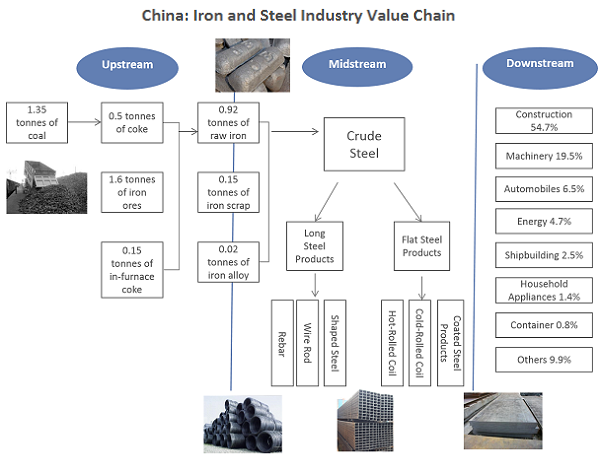 |
|
China’s Iron and Steel Industry – Policy Trends Influence from Policies In China, it is not uncommon that government policies have a great impact on an industry’s development course. The iron and steel industry is no exception, being directly affected by the policies shown below. Major Policies for Iron and Steel Industry
Source: by UZABASE based on various materials |
|
China’s Iron and Steel Industry – Major Tasks and Issues Chinese Iron and Steel Industry Reform:Major Remaining Tasks and Issues After the Twelfth Five-Year Plan
Source: by UZABASE based on various materials
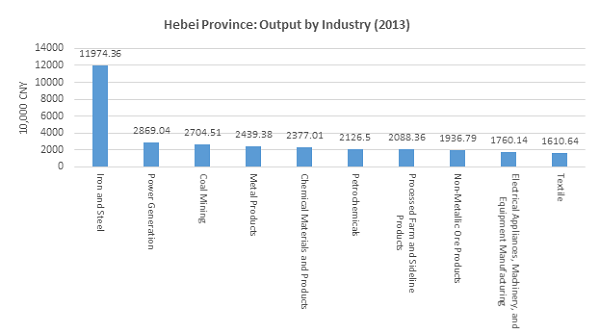 Source: Uzabase
It has proven difficult to enforce the reduction of production output and stimulate M&A activity in Hebei Province. The reason for this is twofold: one, because the iron and steel industry accounts for more than 25% of the region’s total industrial output; and two, because 75% of steel manufacturers in the area are state-run companies. |
|
Chinese Iron and Steel Industry – Major Tasks and Issues Since 2006, China has been gradually discarding ageing and outdated equipment and closing down SMEs in an attempt to curb the output capacity of the iron and steel industry. However, despite such efforts in the elimination of outdated equipment, output reduction has not been progressing as planned due to the number of enduring small- and medium-sized iron and steel mills in Northern China and the successive openings of new iron manufacturing plants in coastal regions. Note that the overall statistics may not be highly accurate because the industry lacks concentration and there are a large number of SMEs that have joined the China Iron and Steel Association (CISA).  Source: CISA |
|
Chinese Iron and Steel Industry – Production Regions and Characteristics Northern and Eastern China Predominant Production Regions, Accounting for Almost 70% of Overall Output Northern China, centred on Hebei Province, and Eastern China, represented by Jiangsu Province and Shanghai, are outstanding in terms of steel output. Combined, they account for roughly 66% of overall output, highlighting the concentration of the industry. By province, Hebei Province holds the largest share of 25.34%, with its output standing at 165.54 million tonnes. It is followed by Jiangsu Province (10.08%, 65.85 million tonnes), Liaoning Province (8.29%, 54.20 million tonnes), and Shandong Province (7.56%, 49.40 million tonnes).Looking at the top five production regions, their combined share on a volume basis has increased from 20% in 2000 to more than 55% as of end-2014 (latest statistics), indicating a trend towards concentration. 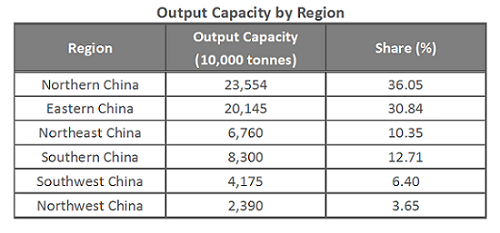 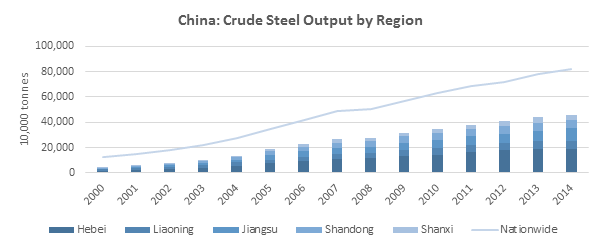 Source: CEInet |
|
Chinese Iron and Steel Industry – Production Regions and Characteristics Continued Shift of Facilities Towards Riverside and Coastal Regions In addition to the opening of new production plants in coastal regions as mentioned above, there has been a steady shift towards and expansion of facilities in riverside and coastal regions. As of end-2014, riverside and coastal regions recorded a combined crude steel output of 121.7 million tonnes, accounting for 17.4% of the national total (refer to Table A). Moreover, adding up the 95 million tonnes of output by production plants that had been approved to move to riverside and coastal regions by September 2009 (refer to Table B), it is estimated that at least 30% of national output will be shifted towards riverside and coastal regions in the future. 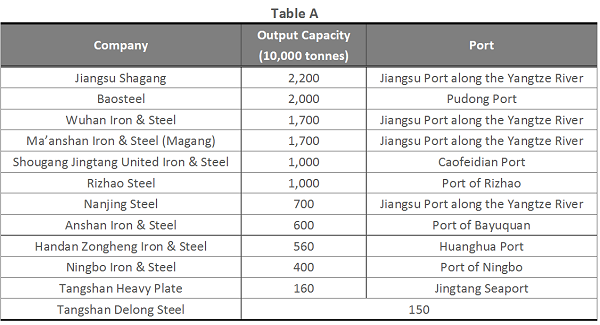 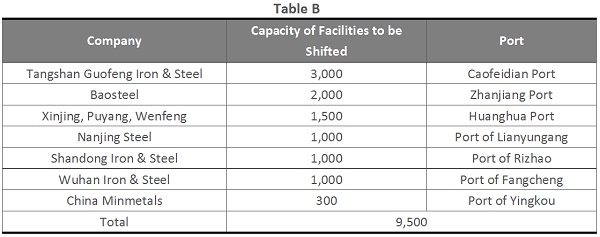 Source: askci.com |
|
Chinese Iron and Steel Industry – Production Regions and Characteristics Map of China’s Iron and Steel Manufacturing Sites
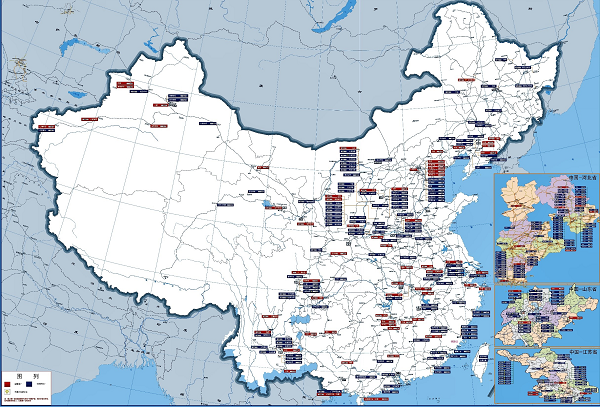 Source: by UZABASE based on various materials |
|
Chinese Iron and Steel Industry – Finding the Way Out: Minor Boost of Domestic Demand and Exports Export Excess Output: Total Capacity 1.05 Billion Tonnes, Domestic Demand 0.52 Billion Tonnes As shown in the graph below, the overall domestic demand for crude steel was roughly 520 million tonnes (tentative calculation) in 2015. According to the National Bureau of Statistics, the total nationwide output capacity was estimated to reach around 1.05 billion tonnes in 2015. The actual effective output was 840 million tonnes based on an assumed operation rate of 80%. Based on simple calculation (excluding inventory), roughly 39% of output was surplus, requiring disposal through exports and other means. Steel material exports increased by 50.7% YoY to reach 93.926 million tonnes in FY2014. As per CEInet data, the accumulated export volume of steel materials hit 112 million as of end-December FY2015.  Source: UZABASE |
|
Driving Factors of Domestic Demand for Steel(2015)
Source: by UZABASE based on various materials
 Source: by UZABASE based on various materials |
|
Chinese Iron and Steel Industry – Elimination of Overcapacity by 2020 Gap Between Excess Output Capacity and Demand for Crude Steel to be Filled by 2020 According to OECD data, the excess output capacity (output capacity – apparent consumption) of crude steel was estimated to be 336–425 million tonnes in China as of 2014, accounting for roughly 50–60% of total global overcapacity. Furthermore, because the expansion in supply has outpaced domestic demand, the balance between supply and demand will continue to deteriorate in China. In response to such trends, the Chinese government has pledged to reduce steel production by 100–150 million tonnes over a five-year period starting from 2015. As shown in the graph below, it is believed that the overcapacity issue will not be solved until 2020. (The calculation is based on opinions from industry specialists which state that by 2020, output capacity will be decreasing at the speed of 100 million tonnes per annum; apparent consumption will increase to 1.0 billion tonnes; and the facility operation rate will remain at the current industry average of 80%.)   Source: by UZABASE based on various materials |
|
Chinese Iron and Steel Industry – Involvement in Global Merger Trends Large-Scale Mergers Expected to Take Place from 2015 Onward Looking back on the past four rounds of global mergers in the iron and steel industry, it is a common phenomenon that mergers and reorganisation take place when the industry is exposed to severe circumstances, with the subsequently occurring mergers and reorganisation activities in turn leading to recovery in the industry. At present, the Chinese iron and steel industry is struggling with a number of factors, most notably overcapacity issues. Moreover, the industry has a low concentration compared to OECD countries, and players operate with negligible profits. Such an environment is believed to be conducive for mergers and reorganisation activity in the industry. cMergers in Iron and Steel Industry 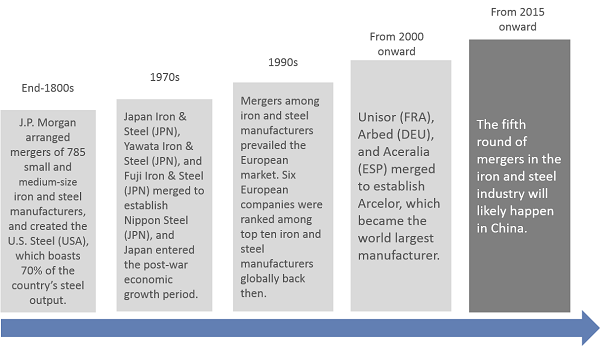 Source: Uzabase |
|
Chinese Iron and Steel Industry – Speculations of Local Governments and Enterprises Various Speculations Among Enterprises and Local Governments A number of companies in the iron and steel industry have been looking toward mergers and reorganisation as a way to break out of the adverse industry circumstances. However, it appears difficult not only for SMEs but also for major players in the industry to realise such merger plans. As of end-2014, there are six mega manufacturers in the Chinese iron and steel manufacturing industry, each of which boasts an annual output exceeding 30 million tonnes. These are Hebei Iron & Steel (CHN), Baosteel (CHN), Jiangsu Shagang (CHN), Anshan Iron & Steel (CHN), Wuhan Iron & Steel (CHN), and Shougang (CHN). In comparison, there are 21 manufacturers that each have an annual output of 10–20 million tonnes. Altogether, their output (approx. 0.82 billion tonnes) accounted for 72% of the national total (1.14 billion tonnes). One of Beijing’s principle guidelines for the iron and steel industry is in spurring the consolidation and reorganisation of manufacturers. However, such plans have encountered numerous setbacks because local governments—a unique political feature of China—are reluctant to carry through, owing to financial concerns. The early-stage failure of the merger between Baosteel and Wuhan Iron & Steel was another factor discouraging the progress of industry consolidation and reorganisation. In addition, policies stipulated by the central government often do not penetrate to regional levels. This is because regional governments generally offer local entities separate favourable policies (for example, in regards to corporate taxation) based on their “locality”, and many aspects of the process lack transparency. |
|
Chinese Iron and Steel Industry – Industry Players Merger Plans Carried Out Behind the Scenes; However, Successful Deals Remain to be Seen The basic form of mergers and acquisitions is that a major manufacturer either forms another industry major or pulls SMEs under its umbrella. However, because major manufacturers are state-run companies, M&As require approval from provincial authorities, which increases the likelihood that the deal will be called to a halt. This issue requires further attention going forward. Find below an overview of current merger deals—including buyers and sellers—based on publicly disclosed information.In particular, the movements of steel manufacturers in Northern China (i.e. Hebei Iron & Steel, Shougang) and Eastern China (i.e. Baosteel, Jiangsu Shagang, Wuhan Iron & Steel, Ningbo Iron & Steel) have been attracting attention. Note that the merger between Baosteel and Wuhan Iron & Steel has been in an impasse. If the deal works out, however, it will create a mega manufacturer with an annual output capacity of over 100 million tonnes, and will likely expedite the progress of other mergers in the industry as well. Aberrant Operation Rate Indicating Chinese Major Manufacturers’ Intentions: No Output Reduction Despite Gloomy Sales As shown in the graph below, each major manufacturer exhibits an abnormally high operation rate of more than 80%. However, in spite of the frustrating market, each company has been playing chicken in a struggle to survive, with the intention of maintaining high production rates until their competitors collapse. This is another factor contributing to the extraordinary operation rate. According to a survey conducted by mysteel.com, a website specialising in iron and steel, the average debt ratio of the 67 steel manufacturers surveyed in 2014 reached a dangerous level of 68.35%, and multiple companies have exceeded 100% in terms of debt ratio. Chinese Iron and Steel Industry – Industry Players
|
|
Chinese Iron and Steel Industry – Each Company Accelerating Entries into Overseas Markets Despite Anti-dumping Measures Each Country Slapping Anti-dumping Duties on China to Protect Domestic Industries; Chinese Players Establishing Factories Overseas Faced with low-priced Chinese exports, many countries have levied anti-dumping taxes in an attempt to protect their own domestic enterprises. To tackle the situation, Chinese industry majors have turned to establishing on-site factories in overseas locations. Anti-dumping Probes and Duties Against Chinese Steel Exports
  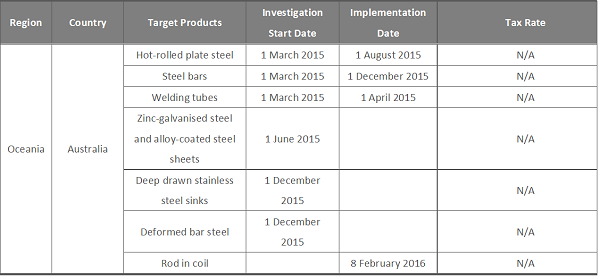   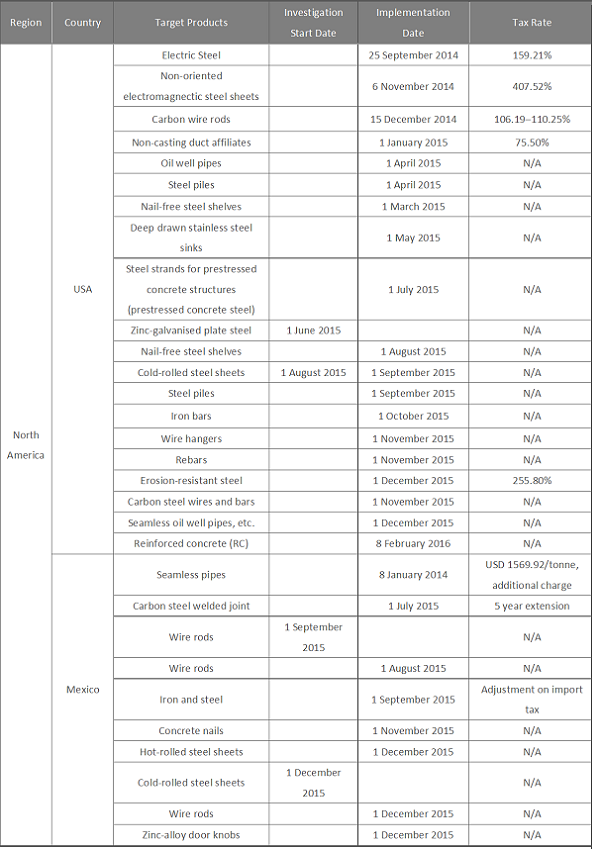 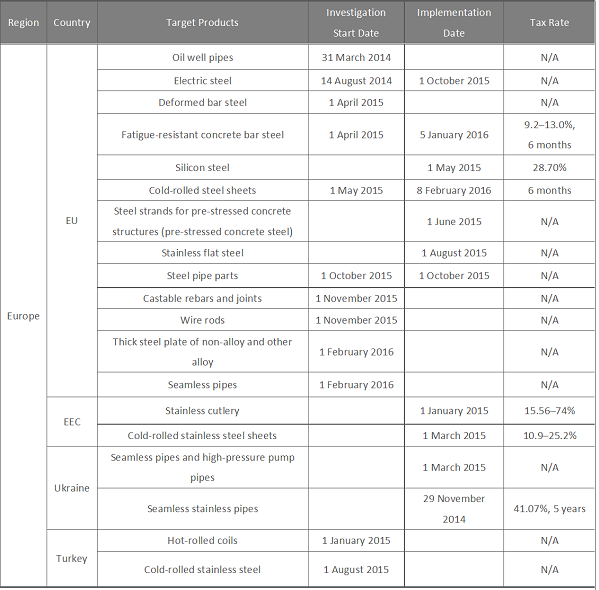 Overseas Entries of Leading Chinese Manufacturers
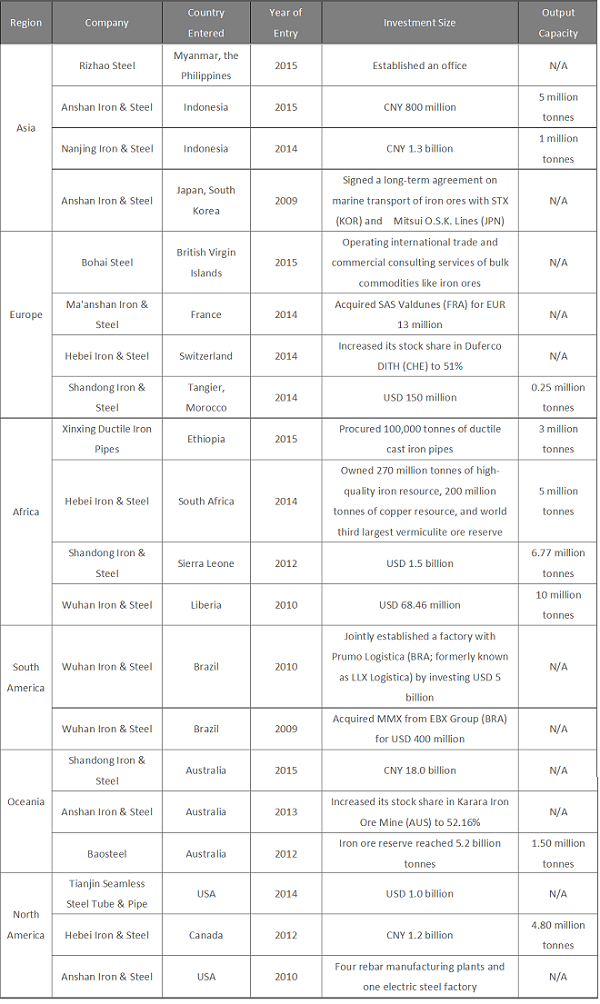 Source: by UZABASE based on various materials |
|
Chinese Iron and Steel Industry – Steel Material Prices Dropping, Likely to Plunge Even Faster Steel Material Prices on Continuous Downtrend; Market Deteriorating Since Early 2015 Compared to end-2012, the prices of major steel materials dived to lower than half of those of October 2015. Given that concrete policies to back the Chinese construction industry have yet to be finalised, these prices are highly expected to plunge further. 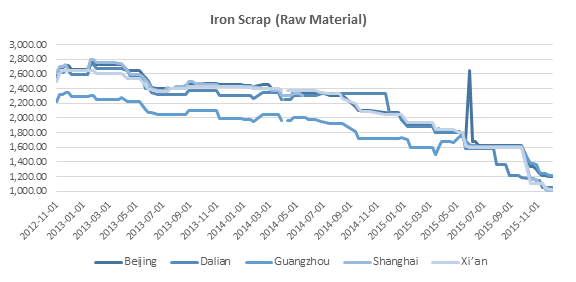 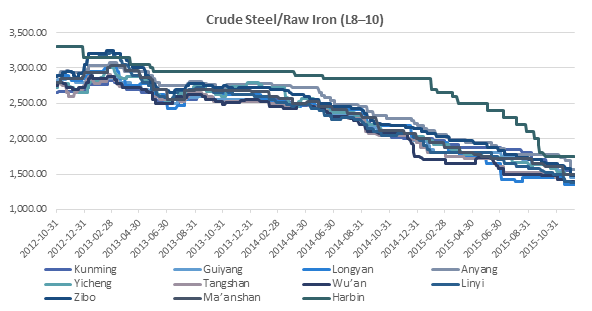 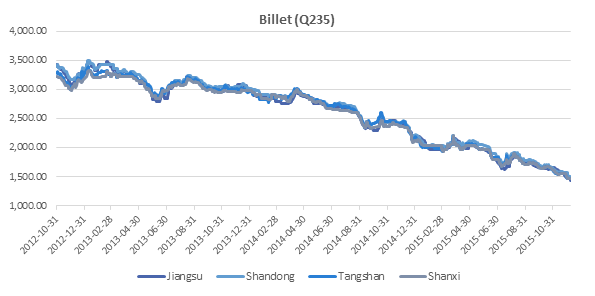 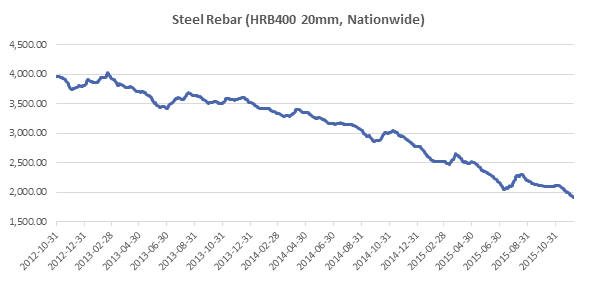  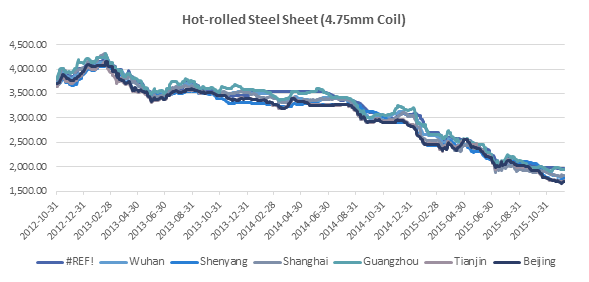  b  Source: by UZABASE based on various materials |
|
Chinese Iron and Steel Industry – A Harsh Winter for the Industry: From the Perspective of Revenue Model Narrow Margin with High Turnover No Longer Attainable for Chinese Steel Manufacturers As demonstrated in the graph “Profit Model Calculation (Tentative)” below, the iron and steel manufacturing industry is already trapped in a negative business cycle, in which manufacturers cannot gain profits even if they manage to sell their products. A variety of products ranging from pig iron and billets to wire rods and plate steel have seen manufacturing costs exceed selling price. In particular, steel rebar, which is mostly used in the real estate construction industry, is in extreme trouble with a unit price of CNY 350–400 per tonne. Moreover, given the forthcoming bubble burst in the real estate industry, as well as the increase in the number of vacant properties in Tier 2 and 3 cities, where real estate sales have been unfavourable, it can be said that a recovery in price is unlikely due to extremely low demand. 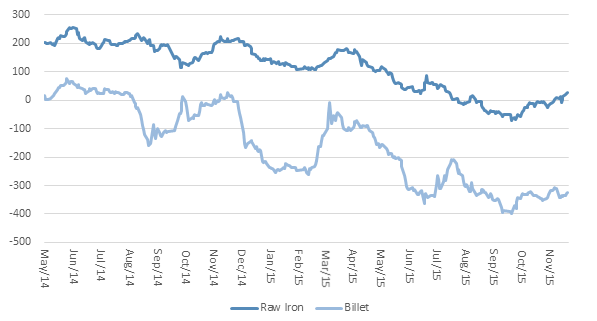 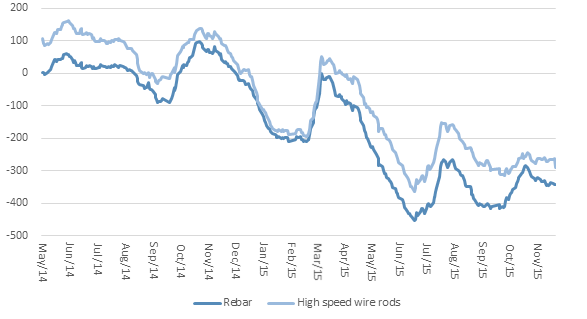 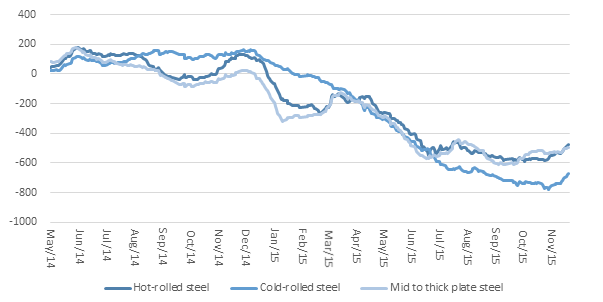 Source: by UZABASE based on various materials
 |
|
Chinese Iron and Steel Industry – Eastern China: Product Unit Price Relatively High, Expected to Recover Soon Market in Eastern China Expected to Recover Sooner than Northern China In regard to regional price difference, steel products—for example rebar and hot-rolled steel sheets—in Northern China (Beijing), where the overcapacity situation is more severe, have a lower unit price compared to Eastern China (Shanghai). The overall recovery for the Northern Chinese market is also slow.  Source: by UZABASE based on various materials
Note: Price difference = Price (Shanghai) – Price (Beijing) |
|
Chinese Iron and Steel Industry – Steel Material Exports Increasing, While Imports Sluggish High-End Market Demand Highly Dependent on Imports, However Some Enterprises Are Introducing High-End Production Facilities Currently, some high-end markets in China (e.g. shape memory alloy and automotive security components) are forced to rely on imports for steel material. As a result, some industry majors have been introducing production facilities for such materials from overseas through large-scale investment. It is forecast that from 2013 onward, exports will continue to expand, while imports will level off until a stable domestic supply of such materials is achieved. 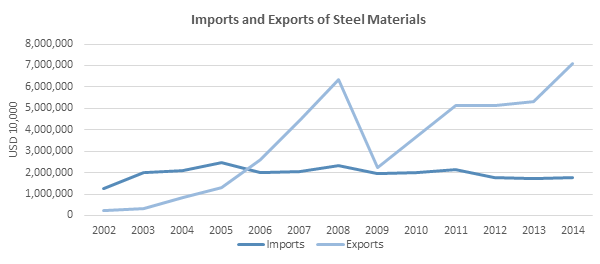 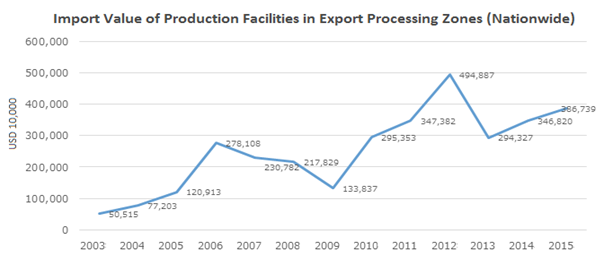 Source: CEInet |
|
Chinese Iron and Steel Industry Looking Ahead: Future Trends Industry players will likely focus more on overseas consumption than domestic demand, and favourable government policies should spur companies to increase the scope of their exports through expansion into global markets. Stricter local regulations and the subsequent increase in M&A activity will see the emergence of mega manufacturer groups, each with an annual capacity of more than 100 million tonnes. These mega manufacturers will have a focus on Northern China, Eastern China, and Southern China, respectively. There is also a need for structural reform, whereby China must reduce its dependence on the construction industry, which currently generates almost 60% of demand for steel materials, and instead look toward development of high-end steel materials used in industries such as automotive security components, aerospace, and nuclear facilities, with the aim of achieving a stable domestic supply of such materials. (Some observers may argue that what China lacks is not the technology and facilities required for these materials, but rather proper management processes). Finally, the government must implement price controls for the steel materials industry. The government should actively employ itself in the pricing system, aiming to reform the current regional price forming mechanism and establish a new one that ensures nationwide price stability. 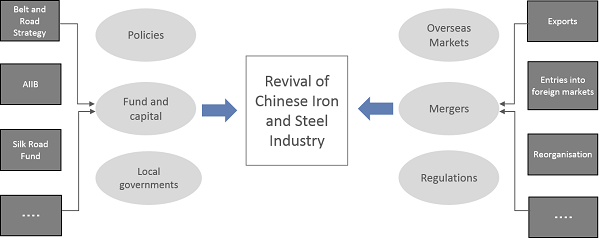 Source: by UZABASE |



